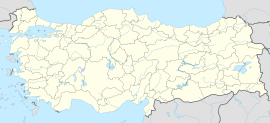Lebedus
Λέβεδος (in Ancient Greek) | |
 Lebedos was located on and around the Kısık Peninsula. | |
| Alternative name | Lebedos |
|---|---|
| Location | Ürkmez, İzmir Province, Turkey |
| Region | Ionia |
| Coordinates | 38°4′41″N 26°57′53″E / 38.07806°N 26.96472°E |
| Type | Settlement |
Lebedus or Lebedos (Ancient Greek: Λέβεδος) was one of the twelve cities of the Ionian League, located south of Smyrna, Klazomenai and neighboring Teos and before Ephesus, which is further south. It was on the coast, ninety stadia (16.65 km) to the east of Cape Myonnesus, and 120 (22.2 km) west of Colophon.
The city was built on and around a very small peninsula (175 m long, reaching a height of 61 m and with an isthmus 201 m wide), which is called the Kısık Peninsula today and depends on the coastal township of Ürkmez, part of Seferihisar locality, a district center depending on the province seat of İzmir.
History
[edit]According to Pausanias, the town was inhabited by Carians when the Ionian Greeks immigrated there under the guidance of Andræmon, a son of Codrus. Strabo, however, states that it was colonized by Andropompus (Ancient Greek: Ἀνδρόπομπος) and that it previously bore the name of Artis in Lydia. Velleius Paterculus wrote that Greeks from Athens established the city as well as other cities in Ionia.[1] Lebedos became a flourishing city thanks to its commerce, and was famous for its mineral springs, but it was one of the smaller cities of the Ionian League, handicapped by the limited space of its hinterland and a comparatively unsuitable port.
In the Hellenistic age, around 304 BC, Antigonus I Monophthalmus tried to join the city with Teos; however, this operation was incomplete and eventually annulled by Lysimachus, who moved its population to Ephesus in 292 BC. At some point, the name Ptolemais (Πτολεμαΐς) was bestowed on the town, probably by Ptolemy III Euergetes.[2]
The poet Horace in one of his Epistles (1.11.7–8) describes it as very quiet: 'a small town more deserted than Gabii or Fidenae'. He imagines his friend Bullatius contemplating a life of retirement there.[3]
Under Roman rule, it flourished anew, becoming the meeting place of the actors of all Ionia when these were temporarily exiled from Teos, and festivals were celebrated in honour of Dionysus.
Its scanty remains are near the modern town of Seferihisar. Pieces of attic black-glazed pottery were uncovered in the area during an archeological survey carried out by Kütahya Dumlupınar University in Turkey between 2017 and 2019. [4]
Ecclesiastical history
[edit]Lebedus was an episcopal see, suffragan of Ephesus until the 12th or 13th century.[5] Three bishops are known: Cyriacus, who witnessed the Second Council of Ephesus in 449; Julian, represented by his metropolitan at the Council of Chalcedon in 451;[6] Theophanes or Thomas, who attended the Second Council of Nicaea in 787.
Lebedus remains as a Roman Catholic titular see.[7]
Sources
[edit]- Bean, George E. (1967). Aegean Turkey: An archaeological guide. London: Ernest Benn. pp. 115-122. ISBN 978-0-510-03200-5.
References
[edit]- ^ Velleius Paterculus, Roman History, 1.4.3
- ^ Getzel M. Cohen (1996). The Hellenistic Settlements in Europe, the Islands, and Asia Minor. University of California Press. pp. 188–191. ISBN 0-520-08329-6.
- ^ Wilkins, A. S. (1892/1964). Horace: Epistles, p. 162.
- ^ Çevirici-Coşkun, Figen (May 2024). "Attic Black-Glazed Pottery from Lebedos Discovered During Archaeological Surveys from 2017 to 2019". DergiPark.
- ^
 Herbermann, Charles, ed. (1913). "Lebedus". Catholic Encyclopedia. New York: Robert Appleton Company.
Herbermann, Charles, ed. (1913). "Lebedus". Catholic Encyclopedia. New York: Robert Appleton Company.
- ^ Richard Price, Michael Gaddis, The Acts of the Council of Chalcedon, Volume 1 (University of Liverpool Press, 2005), p.153.
- ^ Annuario Pontificio 2013 (Libreria Editrice Vaticana, 2013, ISBN 978-88-209-9070-1), p. 914

